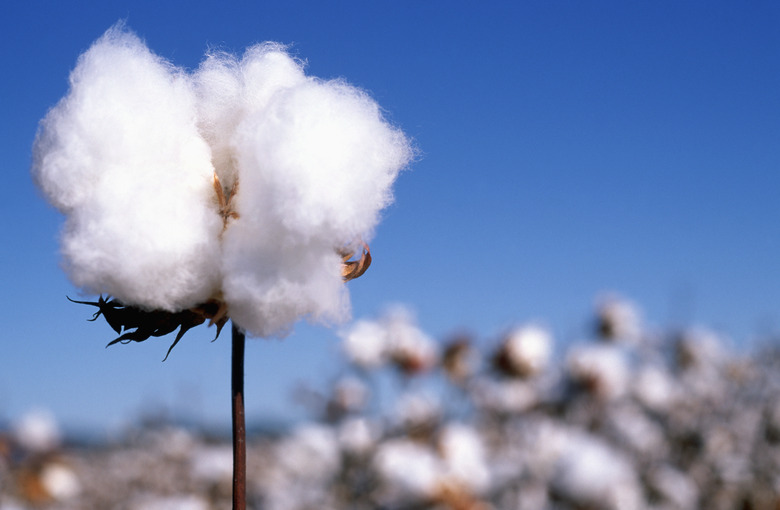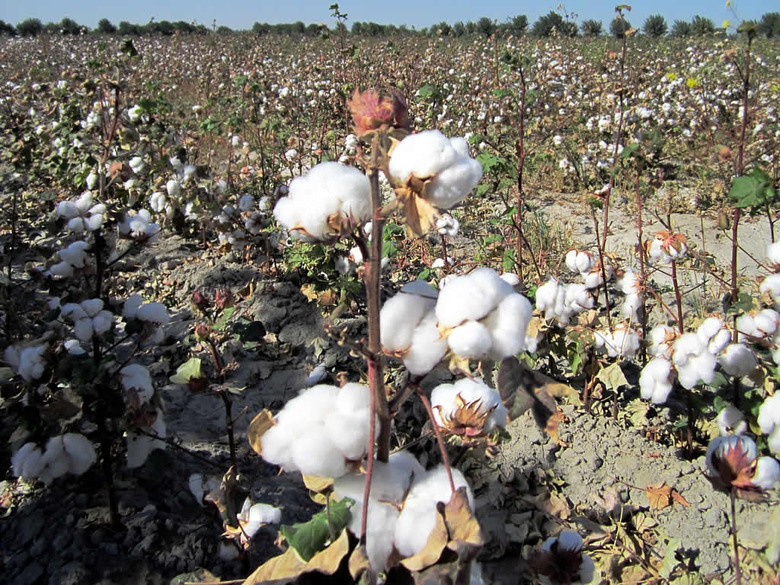The Life Cycle Of The Cotton Plant
Cotton: Annual or Perennial?
The cotton plant's growth cycle is an annual one when it is grown commercially. However, cotton (Gossypium spp.) is a semi-tropical perennial shrub in the Malvaceae family. Its fluffy fiber is produced not to clothe humans but to protect its seeds.
Most of the cotton in commercial production around the world is _G. hirsutum_: 90 percent of all cotton grown is of this species.
Cotton Germination and Planting
Cotton loves heat, and its seeds germinate best at a blazing hot 93.2°F with soil temps of at least 64°F. Experts stress that high-quality seed is critical to producing a high-quality "stand" of cotton plants, which equates to a healthy number of strong seedlings that are evenly distributed in a field. Seeds emerge in four to five days in ideal conditions.
Warning
Soils colder than 60°F limit germination.
The period from germination to the seedling stage is critical to strong stand development. Growers must ensure that the soil has been prepared properly, that it is capable of maintaining a high oxygen content (through proper irrigation and good drainage), that the seed is high quality and that the seed is planted when conditions are optimal.
Root and Stem Development
After germination, the first thing that happens is the taproot shoots straight downward, typically reaching 9 inches before any stem is visible above ground. At this point, the initial cotyledon leaves emerge.
The roots then develop branching from the main taproot, helping the plant absorb moisture and nutrients and anchoring it firmly in the soil. While this occurs, the stem grows stronger and erect and develops nodes and internodes (additional stems between the nodes). These nodes become branches, growing in a spiral formation that may be either clockwise or counterclockwise.
At about four to five weeks, the plant produces what are called "fruiting" branches or "reproductive" branches, i.e. those that form buds rather than additional vegetation.
Tip
Any number of adverse occurrences, such as temperature, excessive or not enough soil moisture, or damage by wind or other factors, can upset this growth and weaken the plant.
Cotton Bloom (Square) Development
The plant throws out its first blooms about five to eight weeks after planting. These are called "squares" and consist of triangular-shaped buds that grow larger for about three weeks before they bloom. The flowers start out white, become pink and then close the day after opening—that's it for the bloom.
It then dries up and falls off after three to seven days, which exposes the "boll," or seed capsule.
Tip
As with germination, if conditions are not just right, the plant is at risk of "boll shedding," in which the boll prematurely drops. Multiple studies have been done on the exact temperature, measured by "heat units," that ensure the cotton plant can successfully bring its bolls to maturity.
How long does it take a cotton boll to mature?
**The typical time from the emergence of the flower to boll maturation is 55 days,** although cloudy weather or cooler temps can delay maturation to 70 days. When the boll matures, it splits open to reveal the shining, white, fibrous cotton mass and seeds.
Harvesting Cotton
While cotton is harvested using machines in the U.S., in many parts of the world it is still harvested by hand. Harvest is an iterative process in which fields are picked two or three times, about three or four weeks apart, to keep the cotton from remaining in the field too long.

